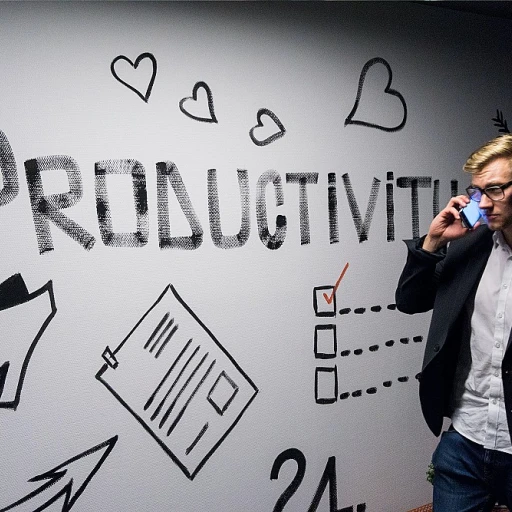
The Evolution of Workforce Enablement
Changes Shaping the Modern Work Environment
Throughout history, the concept of workforce enablement has undergone significant transformation. As organizations increasingly focus on leveraging data-driven strategies to enhance productivity, the role of enabling employees is evolving. Today's businesses face a range of challenges, from maintaining employee engagement to ensuring robust support for the frontline workforce.
An effective workforce enablement strategy doesn't happen overnight. It's built over time, requiring continuous learning and access to development opportunities. Organizations benefit immensely by investing in innovative enablement solutions that align with long-term business goals.
Companies that prioritize responsible employee enablement create positive work environments. This approach not only fosters employee satisfaction but also enhances overall customer satisfaction, as engaged employees often provide better customer service.
Real-time data analytics play a crucial role in facilitating effective decision-making within organizations. Armed with the right tools and technologies, HR can better support workforce development and transformation. In this digital age, organizations must focus on providing the right technology infrastructure to ensure their employees have the necessary resources at their fingertips.
For those interested in further exploring the critical components that drive workforce enablement, consider reviewing this insightful examination of key factors for HR enablers. It presents valuable insights into how organizations can unlock success by focusing on their human resources.
Leveraging Technology for Workforce Empowerment
Revolutionizing Workforce Empowerment Through Technology
In the modern business environment, technology plays a vital role in empowering the workforce, transforming the way employees engage and perform their tasks. The integration of advanced tools and platforms has become crucial for boosting productivity and employee satisfaction within organizations. This evolution is not just about implementing new systems, but about creating a work environment where every team member feels valued and enabled.
One of the primary benefits technology offers is the ability to provide real-time access to resources. Whether it’s training development or data-driven insights, employees now have the tools they need to make informed decisions quickly. This capability not only enhances customer satisfaction but also improves employee engagement by allowing staff to focus on value-driven tasks rather than cumbersome administrative processes.
Technology also facilitates seamless training and development opportunities. Digital platforms now offer personalized learning experiences that cater to the individual needs of each employee. This approach not only addresses the unique challenges faced by different organizations but also lays the groundwork for continuous learning, fostering a culture where upskilling and reskilling are prioritized. As a result, organizations witness significant improvements in employee productivity and service delivery.
Moreover, technology aids in crafting personalized employee experiences which are critical for employee enablement. By leveraging data analytics, organizations can tailor engagement strategies that resonate with the workforce, enhancing employee satisfaction and retention in the long term. This personalized approach ensures that employees feel supported, motivated, and aligned with the organization’s objectives.
According to experts, the future of workforce enablement lies in the strategic use of technology that aligns with core business objectives while enriching employee interactions and experiences.
Furthermore, implementing an effective enablement solution involves ensuring that frontline workforce members have access to both training and tools that support their specific roles, such as patient care or customer service. By addressing their needs, organizations not only improve operational efficiency but also drive exceptional service and product quality, leading to heightened customer satisfaction.
In this rapidly evolving landscape, organizations must strategically embrace technology to resolve business challenges, support employee development, and maintain a competitive edge. The synergy between technology and human resources is a powerful combination for driving business success and elevating the overall work environment.
Personalized Employee Experiences
Creating Tailored Employee Journeys
In the quest to empower the workforce, organizations are increasingly focusing on personalized employee experiences. The aim is not just to improve productivity, but also to foster a deeper connection between the employee and the organization. It's about making employees feel valued and understood in their unique work environment.
Tools powered by data-driven insights are at the forefront of this transformation. By leveraging technology, companies are able to offer real-time access to resources and development opportunities that are specifically tailored to individual needs. This approach not only enhances employee satisfaction but also supports a culture of continuous learning.
For example, using analytics tools, organizations can better understand employee behaviors and preferences, allowing for the customization of training development programs. This targeted approach ensures that employees are equipped with the right skills, ultimately driving productivity and enhancing customer satisfaction.
Furthermore, personalized experiences in the workplace lead to better decision-making support. When employees have access to customized enablement solutions, they are more engaged and capable of contributing to the organization’s success. Interestingly, this personalized approach doesn't just improve internal processes; it also impacts patient care in healthcare settings by enabling frontline workforce members with the right training and tools.
By focusing on individual employee enablement and crafting personalized work experiences, organizations are setting themselves up for long-term success. Interested parties and HR professionals seeking to deepen their understanding of workforce enablement solutions can seek to enhance workplace communication with a modern intranet, thus solidifying the bridge between staff needs and organizational goals.
The Role of Leadership in Workforce Enablement
Leadership as a Catalyst for Workforce Empowerment
In the realm of workforce enablement, leadership plays a pivotal role in shaping the work environment and driving employee engagement. Effective leaders are not just managers; they are enablers who inspire and empower their teams to reach their full potential. By fostering a culture of continuous learning and development, leaders can significantly enhance employee satisfaction and productivity.
One of the key responsibilities of leadership is to provide employees with the necessary tools and resources to excel in their roles. This includes access to real-time data and technology that supports decision-making and improves customer service. Leaders who prioritize employee enablement understand the importance of investing in training development and creating development opportunities that align with both organizational goals and individual aspirations.
Fostering a Supportive Work Environment
Creating a supportive work environment is essential for workforce enablement. Leaders must be proactive in addressing the challenges faced by their teams, ensuring that employees feel valued and supported. This involves regular communication, feedback, and recognition of achievements, which contribute to a positive work culture.
Moreover, leaders should champion initiatives that promote employee engagement and satisfaction. By leveraging data-driven insights, organizations can tailor their strategies to meet the unique needs of their workforce, ultimately enhancing productivity and customer satisfaction. The role of leadership in this context is to guide the organization towards long-term success by nurturing a motivated and capable workforce.
In conclusion, leadership is a critical component of workforce enablement. By prioritizing employee development and fostering a culture of continuous learning, leaders can drive innovation and ensure that their organizations remain competitive in an ever-evolving business landscape.
Building a Culture of Continuous Learning
Creating an Evolving Learning Environment
The traditional work environment has shifted dramatically with the advent of technology and data-driven decision-making. Organizations now understand that cultivating a culture where continuous learning thrives is critical for workforce enablement and employee satisfaction. This approach allows employees across various levels of the organization to access resources, development opportunities, and training tailored to their individual needs. Building a culture that prioritizes learning calls for deliberate effort from leaders and a commitment to integrating learning into every facet of the business. By fostering a culture that supports employee engagement and enables consistent development, businesses can overcome significant challenges and boost productivity.Implementing Continuous Learning Strategies
Several strategies have emerged to promote continuous learning within organizations:- Real-time Access to Educational Tools: By leveraging technology, employees can now access a variety of training development tools, enabling them to adapt and learn at their own pace. The digital work environment supports innovative enablement solutions that make learning seamless and integrated into daily activities.
- Data-driven Learning Insights: Organizations collect and analyze data to provide personalized learning experiences that align with both employee aspirations and business goals. This enhances the productivity of the workforce, instilling confidence in their roles while improving customer satisfaction and patient care.
- Encouraging Lifelong Learning: Beyond meeting immediate business needs, encouraging employees to engage in long-term, continuous learning initiatives helps in fostering a motivated and satisfied workforce. This approach ensures resilience and adaptability in an ever-evolving market landscape.
Future Trends in Workforce Enablement
Pioneering Workforce Enablement for the Future
The landscape of workforce enablement is continually shifting, driven by cutting-edge technology, evolving employee expectations, and dynamic work environments. As organizations strive to remain competitive and meet the challenges of the modern business world, forward-thinking solutions are critical.- Technology-Driven Empowerment: The role of technology is paramount in shaping the future of employee enablement. Tools that support real-time decision making and provide data-driven insights enable employees and leaders to make informed choices that directly impact productivity and customer satisfaction.
- Emphasis on Employee Experience: Personalized experiences aren't just a luxury; they're a necessity. Employees now expect organizations to provide customized development opportunities and access resources that cater to their unique needs. This ongoing evolution demands systems that not only gather data but utilize it effectively to enhance employee engagement.
- Leadership and Cultural Shifts: New leadership models emphasize fostering a culture of continuous learning. By prioritizing learning and development, organizations can facilitate an environment where employees feel supported and have the necessary tools to excel.
- Sustainability and Satisfaction: Enablement solutions must look beyond short-term fixes, focusing instead on fostering long-term initiatives that prioritize employee satisfaction and well-being. Training development and support services play crucial roles in maintaining high levels of employee and customer satisfaction.
- Anticipated Trends: Looking ahead, expect organizations to increasingly utilize data-driven strategies to innovate workforce enablement solutions. This will include integrating customer feedback into employee support mechanisms and adapting to the unique needs of the frontline workforce.












